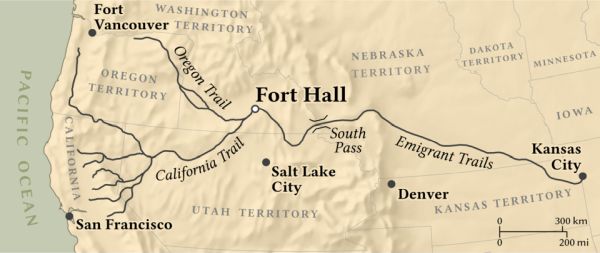1792: Discovery of the Columbia River
Captain Robert Gray sailed into the Columbia River. His journey opened the way for later trade and settlement in the Pacific Northwest.
1823: Rediscovery of South Pass
Fur traders traveled through South Pass in Wyoming. This wide and gentle crossing in the Rocky Mountains made wagon travel into the West possible.
1830s: Early Wagon Journeys
Small groups began using wagons to test the route. Traders proved that wagons could cross the plains. Missionaries then brought families into the West. These early trips proved that long-distance wagon travel was possible. They also set the stage for bigger migrations.
1843: The Great Migration
About one thousand people with more than one hundred wagons set out from Missouri. This proved that large groups could successfully make the journey to Oregon. That same year, Oregon’s Provisional Government was formed to organize the growing settler population.
1845 to 1850: Peak Travel Years
Tens of thousands of people began their trips west from towns such as Independence and St. Joseph, Missouri. Some people wanted farmland in Oregon. Others were attracted to opportunities in California. In 1846, the United States and Britain set the border of the Oregon Territory at the forty-ninth parallel. In 1850, Congress passed the Donation Land Act, which promised free land to settlers in Oregon.
1847: Conflict in Oregon
After a measles outbreak hit the Cayuse Tribe, some warriors attacked the Whitman Mission. They killed several people there. The tragedy was called the Whitman Massacre. It raised tensions between Indigenous peoples and settlers.

1849: The California Gold Rush
News of gold in California pulled many pioneers away from Oregon. Wagon routes split as large numbers of emigrants turned south toward California.
1850s: Disease on the Trail
Cholera and other illnesses spread quickly in crowded wagon trains and at river crossings. Thousands of emigrants died from disease during this period.
1860: The Pony Express
The Pony Express carried mail along parts of the Oregon Trail. It provided quick communication, but it lasted only eighteen months before the telegraph took over.
1862: The Homestead Act
The U.S. government offered 160 acres of free land to citizens who would live on and improve the land for five years. This encouraged more pioneers to move west.
1869: The Transcontinental Railroad
The first railroad across the continent was finished at Promontory Point, Utah. Travel that once took months by wagon could now be completed in less than two weeks by train. The Oregon Trail slowly declined, but some wagons were still seen into the 1880s.
1906 Remembering the Trail
Ezra Meeker, who had first traveled west in 1852, went over the trail again with a wagon to remind people of its history.
